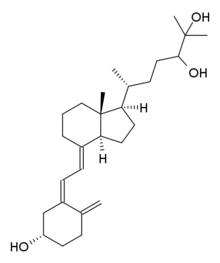Chemistry:24,25-Dihydroxycholecalciferol

| |
| Names | |
|---|---|
| IUPAC name
(6R)-6-[(1R,3aS,4E,7aR)-4-[(2Z)-2-[(5S)-5-hydroxy-2-methylenecyclohexylidene]ethylidene]-7a-methyl-2,3,3a,5,6,7-hexahydro-1H-inden-1-yl]-2-methylheptane-2,3-diol
| |
| Other names
24,25-dihydroxyvitamin D3
(24R)-hydroxycalcifediol (24R)-hydroxycalcidiol | |
| Identifiers | |
3D model (JSmol)
|
|
| ChEMBL | |
| ChemSpider | |
PubChem CID
|
|
| UNII | |
| |
| |
| Properties | |
| C27H44O3 | |
| Molar mass | 416.63 g/mol |
Except where otherwise noted, data are given for materials in their standard state (at 25 °C [77 °F], 100 kPa). | |
| Infobox references | |
24,25-Dihydroxycholecalciferol, also known as 24,25-dihydroxyvitamin D3 and (24R)-hydroxycalcidiol (abbreviated as 24(R),25-(OH)2D3),[1] is a compound which is closely related to 1,25-dihydroxyvitamin D3, the active form of vitamin D3. Like vitamin D3 itself and calcifediol (25-hydroxyvitamin D3), it is inactive as a hormone both in vitro[2] and in vivo.[3] It was first identified in 1972 in the laboratory of Hector DeLuca and Michael F. Holick.[4]
Formation and significance
24,25-dihydroxyvitamin D3 is formed from 25-hydroxyvitamin D3 by the action of CYP24A1 (25-hydroxyvitamin D3-24-hydroxylase). CYP24A1 appears to be "a multicatalytic enzyme catalyzing most, if not all, of the reactions in the C-24/C-23 pathway of 25-OH-D3 metabolism."[5]
It has been proposed that 24,25-dihydroxyvitamin D3 is a metabolite of 25-hydroxyvitamin D3 which is destined for excretion.[5]
It is not known whether the compound might also have some physiologically significant activity. Some evidence of a possible receptor has been obtained.[6]
Because 24,25-dihydroxycholecalciferol is considered an inactive metabolite and its significance is that its concentration is expected to decrease in case of mutations inactivating the vitamin D 24-hydroxylase gene.
Interactive pathway map
References
- ↑ "IUPAC-IUB Joint Commission on Biochemical Nomenclature (JCBN): Nomenclature of vitamin D. Recommendations 1981". European Journal of Biochemistry 124 (2): 223–7. May 1982. doi:10.1111/j.1432-1033.1982.tb06581.x. PMID 7094913.
- ↑ "Calcitriol attenuates the basal and vasoactive intestinal peptide-stimulated cAMP production in prolactin-secreting rat pituitary (GH4C1) cells". Mol Cell Endocrinol 101 (1–2): 183–8. May 1994. doi:10.1016/0303-7207(94)90233-x. PMID 9397951.
- ↑ "Bone turnover in rats treated with 1,25-dihydroxyvitamin D3, 25-hydroxyvitamin D3 or 24,25-dihydroxyvitamin D3". Biosci Rep 13 (1): 27–39. February 1993. doi:10.1007/BF01138176. PMID 8392394.
- ↑ Holick, MF; Schnoes, HK; Deluca, HF; Gray, RW; Boyle, IT; Suda, T (1972). "Isolation and identification of 24,25-dihydroxycholecalciferol, a metabolite of vitamin D made in the kidney". Biochemistry 11 (23): 4251–5. doi:10.1021/bi00773a009. PMID 4342902.
- ↑ 5.0 5.1 "Human 25-hydroxyvitamin D3-24-hydroxylase, a multicatalytic enzyme". Biochemistry 35 (25): 8465–72. June 1996. doi:10.1021/bi960658i. PMID 8679605.
- ↑ "Evidence for 24,25-dihydroxycholecalciferol receptors in long bones of newborn rats". Biochem J 204 (1): 31–6. April 1982. doi:10.1042/bj2040031. PMID 6981414.
Other articles
- Mata-Granados, J. M.; Luque De Castro, M. D.; Quesada Gomez, J. M. (2008). "Inappropriate serum levels of retinol, α-tocopherol, 25 hydroxyvitamin D3 and 24,25 dihydroxyvitamin D3 levels in healthy Spanish adults: Simultaneous assessment by HPLC". Clinical Biochemistry 41 (9): 676–680. doi:10.1016/j.clinbiochem.2008.02.003. PMID 18313404.
 |

